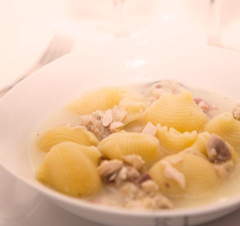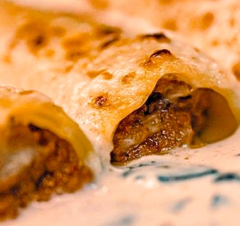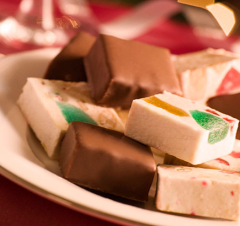Culinary traditions
-
Galets
Soup made with galets is a typical Christmas Day dish. This pasta, shaped like a snail shell, is genuinely Catalan, at least the big shell, which is the typical one for Christmas.
It appears that galets were invented because they had to be smaller than macaroni so people could scoop them up easily with a spoon. If the small variety is used, the soup includes a ball of meat, but if you use the big ones, these are stuffed with minced meat and other ingredients.
The pasta shell soup recipe requires a strong stock made from vegetables, poultry or meat. If you make it richer with things like black or white Catalan sausage (botifarra), or streaky bacon (cansalada), or pig's ear, then you have a Christmas broth, escudella, in all its glory. This is a good dish for warming you up, so maybe that's why we eat it at Christmas.

-
Cannelloni
Cannelloni arrived here in the 19th century, courtesy of the Italian chefs who worked for the bourgeoisie at that time. The recipe rapidly became popular among all social classes, although it is somewhat different to the Italian version.
For example, the pasta is not al dente but softer, while roast meat is used instead of minced meat or sausage. In fact, as making cannelloni is quite a laborious process, it has become popular to eat it on holidays.
So, it's very likely you will find it on the dinner table on Boxing Day. There is a theory that cannelloni is served up the day after Christmas Day so families can make it with the leftovers from the Christmas broth and roast, although not all culinary experts agree with that. Today in many homes you will find cannelloni served with lots of different fillings, including seafood, vegetables and mushrooms.

-
Cava
No Christmas meal could be complete without cava, the drink preferred for toasting the festive occasions, from Christmas Day to New Year's Eve and even Kings Day (January 6). In fact this is the time of year when most bottles of bubbly are sold.
Maybe it's the bubbles, the delicate aroma or the golden colour of most varieties. Whatever the reason, one thing's for sure: cava has become the Christmas drink.

-
Neules
These are a typical Christmas sweet, and are probably the oldest in Catalonia. King Jaume I used to eat them, Ramon Llull talks about them in the Llibre de les Meravelles and the Santes Creus Monastery made them in the 14th century. They say it must have been a nun who invented the neula, when she was rolling a consecrated wafer.
Slowly the recipe for this rolled wafer was perfected and it became crispier. Even in medieval times it was normal to dunk it in piment, wine spiced with honey and pepper.

-
Els torrons
Although it is not known for certain, it is believed that torró is of Arabian origin, if only for the ingredients of the most common variety, namely almond, honey and egg. This Christmas sweet, which also existed in the Middle Ages, was reserved for the rich, who ate it for dessert on special occasions.
However, it gradually became popular and now everybody eats it for Christmas. The varieties range from the more traditional Xixona and Alacant - soft and hard nougat - to the more fancy ones, like chocolate and glazed fruit, without forgetting the more sophisticated, designer ones, such as mojito turron.

-
Grapes
There's a Catalan saying which, loosely translated, goes "eating grapes on New Year's Eve will bring you money all year round". In fact, of all the typical Christmas food, grapes are one of the most recent. The custom of eating a grape, especially the Vinalopó variety, with each midnight chime on New Year's Eve, is just over a hundred years old.
The grape harvest in 1909 produced a surplus and that encouraged people to eat them as they bid farewell to the old year. Before then, though, it's clear some people observed the custom of eating grapes in Puerta del Sol.
Overproduction helped to popularise it and later it became established, thanks to TV broadcasts of the twelve chimes.

-
El tortell de Reis
This ring-shaped kings cake, with glazed fruit and stuffed with marzipan and cream, is the real king on Kings' Day, although you can also eat it the night before. What's special about it is there is a bean and a figurine of a king hidden inside. Whoever finds the bean has to pay for the cake, while whoever finds the figurine will be crowned king.
It appears that the tortell de reis might be linked to the Roman Saturnalia, winter festivals held in honour of Saturn, because this ancient civilisation used beans to vote for the festival king and also ate ring cakes made from figs, dates and honey.


